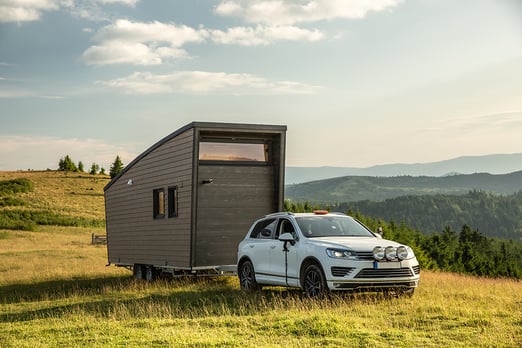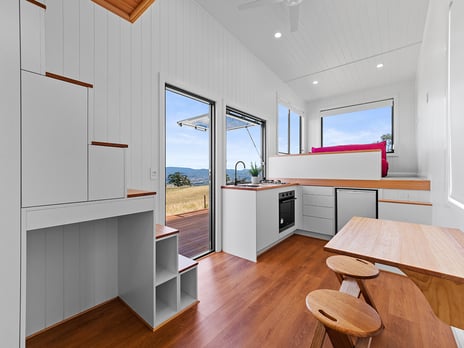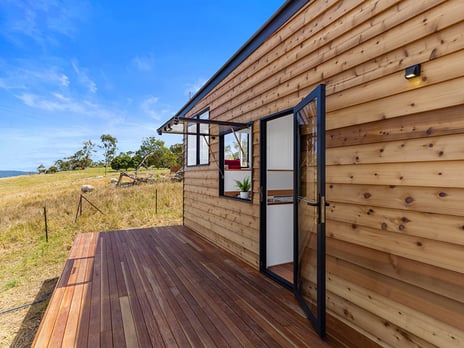5 benefits of a sustainable tiny home vs a normal house

No matter what you call them - tiny homes, tiny houses, micro-homes, mini houses or ultra-small buildings, one thing is clear. These sustainable, off-grid, pint-sized dwellings are packed with big benefits when compared to your average home. They are a great option if you're looking for a full-time living solution, an alternative to a traditionally built granny flat or to use for your weekend getaways.
As well as the obvious cost savings, smaller land requirements and portability of a tiny house, there are many environmental and lifestyle advantages too. Here are just five of the many benefits to buying or building a sustainable, off-grid tiny home instead of a ‘normal’ home.
1. Cheaper to build
It makes sense that a tiny home will be cheaper to build than a larger counterpart. For a start, a tiny house can be erected in a day (or even less) instead of the weeks or months it takes to complete a normal home.
A tiny house requires far fewer materials to construct. If you packed all the building materials required to complete your typical suburban home into trucks, you’d need seven of them! Compare that to the half a truckload of material required to build an average tiny home.
Seven truckloads! That’s a lot of timber, steel and concrete, which all has a massive impact on the environment. Add to that the cost of transportation and remember to include all the floor and window coverings, fixtures, fittings and appliances.
Because less material is needed, it's also easier to build a tiny home using high quality materials. You can’t always do the same with a large house due to the quantities needed. That’s why home builders often use cheaper building products to keep costs down or otherwise charge you more for quality and quantity.
2. Smarter design features

With the tiny home movement continuing to grow, more designers are getting on board in a bid to create the ‘smartest’ compact living spaces. It’s become a competitive industry leading to greater benefits to the tiny home buyer.
Because of their size, clever design is crucial to maximise the space and deliver the comforts required. Tiny homes incorporate intelligent use of storage areas, include functional furniture and space saving appliances as well as features that serve multiple purposes or can hide away when not in use.
Vertical space is also optimised to ensure that every aspect of the tiny home is being utilised in the most practical way.
3. Less maintenance
If a tiny home is cheaper to build, it stands to reason it will have tiny maintenance costs as well! There is simply less to repair, maintain and clean which equates to big savings for you in time, energy and money. This is one of the most appealing aspects of owning a tiny home.
Even if it’s just keeping up with the cleaning, it’s going to take a lot longer to get all the chores done around your four-bedroom house than it is to flick the dust buster over your small abode.
If you’re used to hiring someone else to do the job, you won’t need to as most tiny homes can be tidied in just a few minutes. Another cost saving!
In a normal home, there are more opportunities for things to go wrong. Think about the lifetime costs of repairing roofing, painting, reflooring, updating furniture and fittings, even gardening. Imagine the difference in the time, cost and upheaval involved in just recarpeting one bedroom in a normal house versus throwing out the old rug and rolling out a new one in your tiny home!
The more time you spend on the upkeep of a home, the more it eats into your leisure time. Most tiny homeowners are pleasantly surprised at how much time they free up when not faced with a weekly to do list of cleaning and maintenance; time they can now spend on activities they love.
4. Reduced energy costs
The cost of electricity is already expensive, no matter the size your home. It makes sense then that a smaller space is going to be much cheaper to heat or cool and to provide lighting or power your appliances. The average tiny house has just six lightbulbs compared to the average of forty-five in a larger house!
Sure, you can switch to solar if you have a normal home and save money that way, or even make money if you’re selling it back to the grid. But here’s a unique benefit of a solar powered tiny home.
A normal home is built to a certain aspect to take advantage of the seasons, weather and time of day. Solar panels are fixed to the roof to maximise the sun’s rays. That’s it. Once built, you can’t move your house or shift the solar panels. You can with a tiny home because most tiny homes are portable. They can be moved under a tree in summer and positioned to catch the sun’s energy in winter.
Your solar can be portable too. Instead of being fixed to the roof of your tiny house, you can buy solar panels on a separate trailer which can be moved throughout the year to make the most of changing conditions. For cloudy days, you can invest in a small generator that will provide plenty of power to your tiny home. You’ll also be running fewer appliances and electrical fixtures – remember, six lightbulbs!
A water tank is a must if you’re wanting to live completely off-grid. You may need to buy water in times of low rainfall, but your tiny home will be fitted with water-saving devices and most tiny home buyers become increasingly mindful of reducing their use of this precious resource.
To live in a tiny home can cost you as little as $12 a month in gas for cooking, with free electricity and free water. If your tiny house is running fully on solar powered electricity, you can cut your energy expenses to zero. It doesn’t get much cheaper than that!
5. Kinder to the environment

The way people build things today matters. Every decision has an impact. As already mentioned, your tiny home uses far fewer building supplies with less energy required to transport them. Throughout the life of your tiny home, the maintenance will be minimal, hence a smaller need for materials. Even cleaning supplies are reduced to a minimum.
Your tiny home is self-sufficient, producing its own power and collecting its own water and you are making the most of the sun’s energy by moving your home (and solar trailer) to suit the seasons.
Less space equals fewer possessions, a decrease in consumables means less packaging and less waste. As your consumption drops, so does your environmental impact. And, just as your tiny home has less space inside, it also takes up less space outside, which means it has a smaller ecological footprint.

Ready to go tiny?
If you’d like to explore the benefits of downsizing into a tiny home, please contact us or browse through our selection of designs. We offer completed tiny houses that are delivered to your block, ready to move in. So go tiny with the Alphaline team today.
